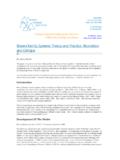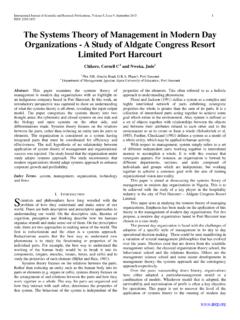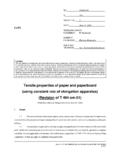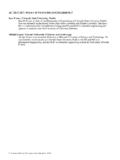Transcription of Applications of Dynamical Systems Theory to Football
1 Applications of Dynamical Systems Theory to Football Keith Davids, School of Physical Education, University of Otago, New Zealand Duarte Ara jo, Faculty of Human Kinetics; Technical University of Lisbon and Rick Shuttleworth, School of Physical Education, University of Otago, New Zealand Football is a tactically sophisticated sport requiring understanding of coordination processes within and between players during performance of key dynamic interceptive actions such as passing, shooting and dribbling, heading or catching/punching the ball.
2 Dynamical Systems Theory is an interdisciplinary framework, utilised to study coordination processes in physical, biological and social Systems , which has considerable potential for the study of team ball games, including different codes of Football . Recent Applications of Dynamical Systems Theory to team ball games have examined coordination processes at two different levels. The first level of analysis concerns coordination of dynamic interceptive actions in performers modelled as movement Systems ( , Davids, et al.)
3 , 2000;. Davids, et al., 2002). Movement coordination and control in footballers conceived as Dynamical movement Systems involve two dimensions: (i) coordination between important limb segments to ensure a proximo-distal temporal sequencing in the movements of joint segments of the lower limb when kicking, to facilitate the development of high velocities in the distal segment; and (ii) coordination between a moving ball and an effector is moved to satisfy the spatio-temporal constraints of interception with a controlled amount of force.
4 The second level of analysis has attempted to model the dynamics of interpersonal coordination within patterns of play emerging in typical sub-phases of team ball games such attack and defence and 1 v 1 situations (Grehaigne et al., 1997; McGarry et al., 2002; Ara jo et al., 2003). These Applications are providing useful insights into processes of motor skill acquisition and tactical development for players and coaches. The aims of this paper are to: (i) present an overview of the theoretical constructs and concepts of Dynamical Systems Theory which are highly relevant for the study of coordination processes at different levels in the context of Football ; (ii) review some current data emerging from these modelling attempts; and, (iii) draw some implications for coaching behaviours from the main empirical and theoretical developments in a constraints-led approach.
5 Dynamical Systems Theory AND COORDINATION. PROCESSES IN Football . Generally, nonlinear Dynamical Systems are highly inter-connected Systems composed of many interacting parts, capable of constantly changing their state of organisation ( , weather Systems ; societies; chemical Systems ). Complex, Dynamical Systems in nature have several key characteristics important for the study of coordination processes in Football . First, fractal analysis in chaos Theory has revealed self-similarity between localised sub- system behaviour and global system behaviour.
6 In Applications to Football , the characteristic of self-similarity implies that the same underlying principles can be used to explain coordination processes in localised sub- Systems ( , the emergence of patterns of movement coordination in individual players) and the global system ( the emergence of tactical patterns during sub-phases of Football including 1 v 1, 3 v 3 and 11 v 11. situations). Second, Dynamical Systems can display nonlinearity of behavioural output and have a capacity for stable and unstable patterned relationships to emerge between system parts through inherent processes of self-organisation under constraints ( , these Systems can spontaneously shift between many relatively stable states of coordination (Davids et al.))
7 , 2004)). Constraints on Football Players as Dynamical Movement Systems Understanding how coordination emerges in Dynamical movement Systems , with their huge number of micro-components, was defined as the fundamental question in the human movement sciences and has become known as Bernstein's (1967). degrees of freedom problem ( , Turvey, 1990). The degrees of freedom of the human body are the many different parts, for example the muscles, joints and limb segments, which are free to vary in position and movement. Bernstein's (1967).
8 Seminal definition of movement coordination neatly captured the fundamental problem. The achievement of coordination between parts of the human body was viewed as the process of mastering redundant degrees of freedom of the moving organ, in other words its conversion to a controllable system ( ). Despite the proliferation of degrees of freedom, Dynamical movement Systems show a surprising amount of order, and it has been known for some time that functional patterns of coordination emerge in individual performers to satisfy competing and cooperating task, informational and environmental constraints ( , Newell, 1986).
9 Such classes of constraints interact to pressure the individual movement system into changing its organisational state during dynamic interceptive actions, such as kicking, punching or catching a ball. Newell's (1986) model of interacting constraints and self-organisation processes has been applied to the study of coordination and control of dynamic interceptive actions in sport (for many examples see Davids et al., 2002; Davids et al., 2004). According to the model, coordination and control emerge under constraints and a relevant question concerns how the motor system degrees of freedom are specifically harnessed during learning of Football skills.
10 Bernstein (1967) highlighted the formation of specific functional muscle-joint linkages, later known as coordinative structures, as a method of constraining the large number of degrees of freedom to be regulated in the human movement system . Coordinative structures act as physical constraints, which specify how individual movement system degrees of freedom can become mutually dependent. Anderson and Sidaway (1994) revealed support for these ideas in soccer players. In their study, novices initially showed joint ranges of motion of lower magnitude during kicking practice, compared to more skilled counterparts who exhibited coordinative structures characterised by greater values of flexion and extension in the knee and hip joints.






